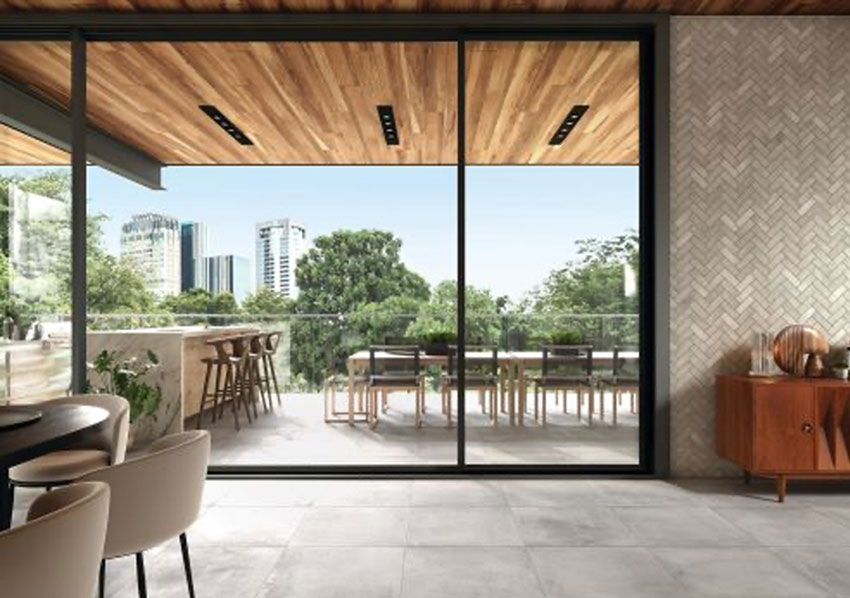Exploring Innovations in Exterior Ceramic Tile Design
 1.25 AIA LU/HSW; 1 IDCEC CEU/HSW; 0.1 ICC CEU; 0.1 IACET CEU*; 1 AIBD P-CE; AAA 1 Structured Learning Hour; This course can be self-reported to the AANB, as per their CE Guidelines; AAPEI 1 Structured Learning Hour; This course can be self-reported to the AIBC, as per their CE Guidelines.; MAA 1 Structured Learning Hour; This course can be self-reported to the NLAA.; This course can be self-reported to the NSAA; NWTAA 1 Structured Learning Hour; OAA 1 Learning Hour; SAA 1 Hour of Core Learning
1.25 AIA LU/HSW; 1 IDCEC CEU/HSW; 0.1 ICC CEU; 0.1 IACET CEU*; 1 AIBD P-CE; AAA 1 Structured Learning Hour; This course can be self-reported to the AANB, as per their CE Guidelines; AAPEI 1 Structured Learning Hour; This course can be self-reported to the AIBC, as per their CE Guidelines.; MAA 1 Structured Learning Hour; This course can be self-reported to the NLAA.; This course can be self-reported to the NSAA; NWTAA 1 Structured Learning Hour; OAA 1 Learning Hour; SAA 1 Hour of Core Learning
Learning Objectives:
- Explain the characteristics that make ceramic tile eco-friendly and provide health and safety for occupants.
- Discuss some of the looks and styles architects can achieve with ceramic tiles in outdoor applications.
- Describe the latest eco-friendly and healthy outdoor applications for gauged porcelain tile pavers (2cm and thicker) and gauged porcelain tiles and tile panels/slabs (as thin as 3.5mm).
- List new codes, standards, and certifications discussed in this article associated with ceramic tile’s contribution to healthy and green building.
This course is part of the Tile Academy
Rooftop Terraces
Ceramic tile has a long history as a material for rooftop terraces. In many cultures, including Mediterranean and Middle Eastern cultures, ceramic tile has been used for centuries as a roofing material because of its durability, weather resistance, and aesthetic appeal.
In the early 20th century, ceramic tile became a popular material for rooftop terraces in the United States, particularly in cities where there was limited indoor living space. In the mid-20th century, other materials like rubber and asphalt were often used for rooftop terraces. But in recent years, ceramic tile has experienced renewed interest from architects and owners. The reasons? Sustainability, longevity, and aesthetic versatility, among others.
Roof decks, in general, have become more popular since the pandemic. They are often incorporated into new construction for single-family homes and multifamily residential and mixed-use commercial buildings. Other times they are added to replace an undeveloped rooftop. A typical undeveloped rooftop has little to no value for owners or tenants. By installing ceramic tile such as porcelain tile pavers, the rooftop is transformed into a destination, potentially hosting a myriad of activities with coveted views, from cityscapes to mountains. The “found space” aspect of turning an undeveloped roof into a vibrant, usable space can revitalize a building and add value to a property without owners investing in a huge renovation or addition.
Architects interested in human-centered design, health, and sustainability take into consideration how occupants experience a space. A roof deck in a multifamily building creates a unique space removed from normal daily routine. In a single-family home, it can serve as an oasis or green space for gardening. Rooftop decks have an allure embedded in a culture of leisure and as a place for community to develop. The pandemic taught people to enjoy life, expect more of our spaces, and attend to our health and well-being. Roof decks embody that concept.
But, to fulfill that role, they have to be functional, which is why a durable surface material like ceramic tile is key. Ceramic tile provides a long-lasting, fade-resistant assembly and serves to protect the roof itself – with very little maintenance needed. Along with the attributes the ceramic tile family shares, architects can specify slip-resistant options, making roof decks safer for people (and pets). And they can choose ceramic tile with the best freeze-thaw resistance.

LDaltile Rekindle; image courtesy of Tile Council of North America
Architects can employ ceramic tile seamlessly in their designs for both indoor and outdoor spaces, ensuring durability and style are not compromised.
Indoor-Outdoor Spaces
Another trend that has seen an uptick since the pandemic is indoor-to-outdoor living spaces. Social distancing and other social shifts allowed homeowners, developers, and architects to reimagine pandemic social spaces in more permanent ways. Indoor-to-outdoor flooring designs create a seamless transition between indoor and outdoor spaces. This design creates continuity and flow and makes the connected spaces feel more cohesive and unified. By using the same flooring material inside and outside, architects can create a more functional space better suited to the occupants. A space that is used for entertaining, for instance, can be extended seamlessly from the inside to the outside, providing more space for guests.
Ceramic tile is unique in comparison to other flooring materials because it can be used both indoors and out. An architect can create a design using the same ceramic tile for both spaces without compromising durability or style. The ability to transition ceramic tile flooring from inside to outside─with the benefit of so many aesthetic options─blurs the line between the spaces. This transitional design is particularly effective in spaces with large windows or glass doors, because of the visual connection created between inside and outside. Ceramic tile’s other attributes benefit inside-to-outside spaces. For instance, its fade-resistance, stain-resistance, and cleanability help preserve the seamless look.
With indoor-to-outdoor spaces, moisture is more likely to sneak indoors, but the same tile protecting against the elements outdoors can withstand moisture coming indoors, too. Indoor-to-outdoor spaces can be applied in a variety of ways: living room to patio, bedroom to outdoor fireplace, bathroom to pool, and other combinations. And because ceramic tile is fire resistant and includes slip-resistant options, these combinations of spaces can be designed with safety in mind.
Outdoor Kitchens
Outdoor kitchens have also become increasingly popular in recent years. With the growing trend of spending more time at home and entertaining guests in outdoor spaces, homeowners are investing in outdoor kitchens to enhance their outdoor living experience.
Advances in outdoor kitchen design and technology have made it easier and more convenient to create fully functional outdoor kitchens. There are now a wide variety of outdoor kitchen appliances and fixtures available that can withstand outdoor conditions. Ceramic tile makes this outdoor environment possible because of its attributes, including durability. In addition, the variety of ceramic tile looks can help designers create an aesthetically stunning space that goes far beyond a simple grilling area.
When specifying materials for outdoor kitchens, water resistance is especially key. All ceramic tile is water resistant, and porcelain, quarry tile, and some pressed floor tiles and mosaic can withstand repeated freeze-thaw cycles. Ceramic tile is also easy to clean even when exposed to food and drink. Applications for ceramic tile in outdoor kitchens include countertops, kitchen islands, bars, stoves, and ovens, as well as firepits or fireplaces surrounded by tile.
Countertops provide a good canvas for aesthetic design. Gauged porcelain tile panels and slabs are one popular option to create a natural stone look and can withstand marring from sharp utensils and heavy dining décor. Bars and kitchen islands are often part of an outdoor kitchen design. These types of areas are prone to food and drink spills, but using ceramic tile makes for a surface that is easily cleaned and stain resistant.
Additionally, if an outdoor kitchen design incorporated a pool, using ceramic tile as a floor surface between the two spaces would prevent water damage and be resistant to pool chemicals. Using ceramic tile around outdoor stoves, ovens, fire pits, and fireplaces provides aesthetic opportunities. But it also offers added safety because of ceramic tile’s inherent flame resistance. For all the reasons given above, ceramic tile is a material that fits well with indoor-outdoor kitchens, as well as any adjacent outdoor spaces or pathways.
EVOLVING TECHNOLOGIES
It’s not just the types of applications that are evolving. Ceramic tile options are expanding as new technologies emerge. Digital printing and ceramic tile manufacturing processes have helped push color and texture options into new territory. Ceramic tile can now be specified to create more realistic visuals that emulate other materials such as wood, marble, stone, and concrete. New technologies, testing standards, and building codes have given rise to the more widespread use of gauged porcelain tile pavers that are 2 cm and thicker, as well as porcelain tile panels/slabs that are literally changing the faces of buildings.
New Tile Technologies and Tile Trends
The trend toward outdoor living spaces has led to the rapidly growing popularity of gauged-porcelain tile pavers that are 2 cm or thicker. This category of tile is being employed as an alternative to traditional pavers made from concrete or brick. Gauged porcelain pavers can be installed using different methods, which makes them a versatile choice for outdoor applications. They can also be installed traditionally using adhesives.
This method is a smart choice for porches, garages, parking spaces, and other areas subject to heavy loads. In recent trends, they are being used in on-grade paver applications – on sand, grass, and gravel – without adhesives. They are also being used as raised flooring with pedestal systems on decks and rooftop patios. The 2cm+ thickness provides durability in terms of breaking strength and impact resistance. And as with all porcelain and ceramic tiles, slip-resistant options are available to suit the needs of a project. Aesthetic-wise, some gauged porcelain tile pavers provide a good choice for indoor-outdoor design flow.
The term “gauged” refers to tile precision engineered for a specific thickness and performance, using advanced production technology. Traditionally, gauged tile has been used to describe tile meeting ANSI A137.3 that is much thinner than ordinary tile, as slim as 3.5 millimeters (a little more than 1/8 inch) thick.
The rising popularity of thicker gauged porcelain tile pavers has led to recent updates to the ANSI A137.3 standard. The update now also defines gauged as applying to tile that is 2 cm and thicker, which is still relatively thin in comparison to traditional pavers of stone or cement. The standard update required hundreds of hours of research over three years with special attention given to strength and impact criteria, which should ensure more successful paver installations that also allow for creative design.
This update to the standard expands the possibilities for successfully using ceramic tile pavers in outdoor spaces, allowing for more creative and functional design options while maintaining the durability and low maintenance characteristics of ceramic tiles.

Daltile Panoramic Porcelain; image courtesy of Tile Council of North America
The diverse selection of ceramic tile appearances empowers designers to craft aesthetically breathtaking spaces that surpass mere grilling areas.

Florida Tile NY2LA; image courtesy of Tile Council of North America
Gauged porcelain pavers can be installed using different methods, which makes them a versatile choice for outdoor applications.











